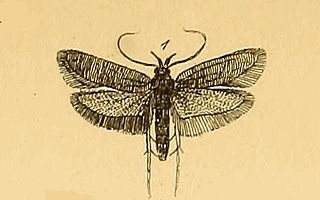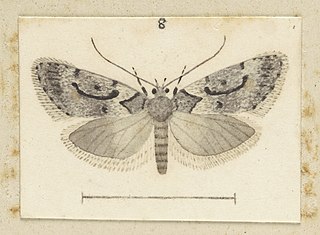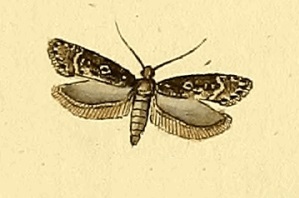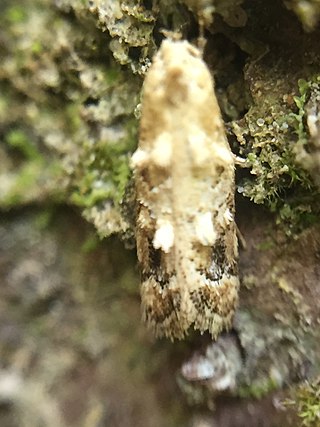Related Research Articles
Flexiptera is a monotypic moth genus in the family Gelechiidae erected by Anthonie Johannes Theodorus Janse in 1958. Its only species, Flexiptera revoluta, was first described by Edward Meyrick in 1918. It is found in South Africa.

Udea prunalis is a moth of the family Crambidae. It is found in Europe and China. The species was first described by Matthew Denis and Ignaz Schiffermüller in 1775. In the Butterfly Conservation's Microlepidoptera Report 2011 this species was classified as common in the UK.

Falcaria lacertinaria, the scalloped hook-tip, is a moth of the family Drepanidae. The species was first described by Carl Linnaeus in his 1758 10th edition of Systema Naturae It is found in Europe and Anatolia then east to Eastern Siberia.

Gastropacha quercifolia, the lappet, is a moth of the family Lasiocampidae. It is found in Europe and east across the Palearctic to Japan.

Ceuthomadarus is a genus of moth in the family Lecithoceridae.

Hellinsia tephradactyla is a moth of the family Pterophoridae found in most of Europe. It was first described by the German taxonomist Jacob Hübner in 1813.

Izatha manubriata is a moth of the family Oecophoridae. It is endemic to New Zealand, where it is known from the southern South Island only.
Caryocolum marmorea is a moth of the family Gelechiidae. It is found from Scandinavia to the Mediterranean islands, and from Ireland to Poland, Hungary and Greece. It is also found on the Canary Islands and Madeira. It is also found in North America.
Anarsia semnopa is a moth of the family Gelechiidae. It was described by Edward Meyrick in 1921. It is found in Mozambique, South Africa and Zimbabwe.

Gelechia sororculella, the dark-striped groundling, is a moth of the family Gelechiidae. It is widely distributed from Europe, throughout Siberia to the Russian Far East.
Compsoctena scriba is a moth in the family Eriocottidae. It was described by Edward Meyrick in 1921. It is found in Lesotho, Malawi, Mozambique, South Africa, Tanzania, Zambia and Zimbabwe.
Dichomeris monococca is a moth in the family Gelechiidae. It was described by Edward Meyrick in 1921. It is found in Mozambique.
Dichomeris pleuropa is a moth in the family Gelechiidae. It was described by Edward Meyrick in 1921. It is found in South Africa.
Dichomeris finitima is a moth in the family Gelechiidae. It was described by Edward Meyrick in 1921. It is found in Zimbabwe.
Dichomeris coenulenta is a moth in the family Gelechiidae. It was described by Edward Meyrick in 1927. It is found in Zimbabwe.
Gelechia anagramma is a moth of the family Gelechiidae first described by Edward Meyrick in 1921. It is native to South Africa.
Gelechia sematica is a moth of the family Gelechiidae first described by Edward Meyrick in 1913. It is found in Namibia and South Africa.
Aristotelia chlorographa is a moth of the family Gelechiidae. It was described by Edward Meyrick in 1914. It is found in Mozambique and South Africa, where it has been recorded from Gauteng.

Proteodes melographa is a species of moth in the family Depressariidae. It is endemic to New Zealand and has been observed at Mount Arthur and in the Nelson District. It inhabits forest in the alpine zone. The larvae of this species feeds on native beech trees.

Trachypepla aspidephora is a species of moth in the family Oecophoridae. It is endemic to New Zealand and has been observed in the North and South Islands. Adults are on the wing from November to March and are attracted to light. The moths can be found resting on tree trunks where their colouration imitates lichens.
References
- ↑ Savela, Markku (August 24, 2014). "Ceuthomadarus chthoniopa (Meyrick, 1936)". Lepidoptera and Some Other Life Forms. Retrieved August 19, 2020.
- ↑ "Exotic Microlepidoptera. 5 (2): 49" (PDF). Archived from the original (PDF) on 2016-03-04. Retrieved 2016-02-04.